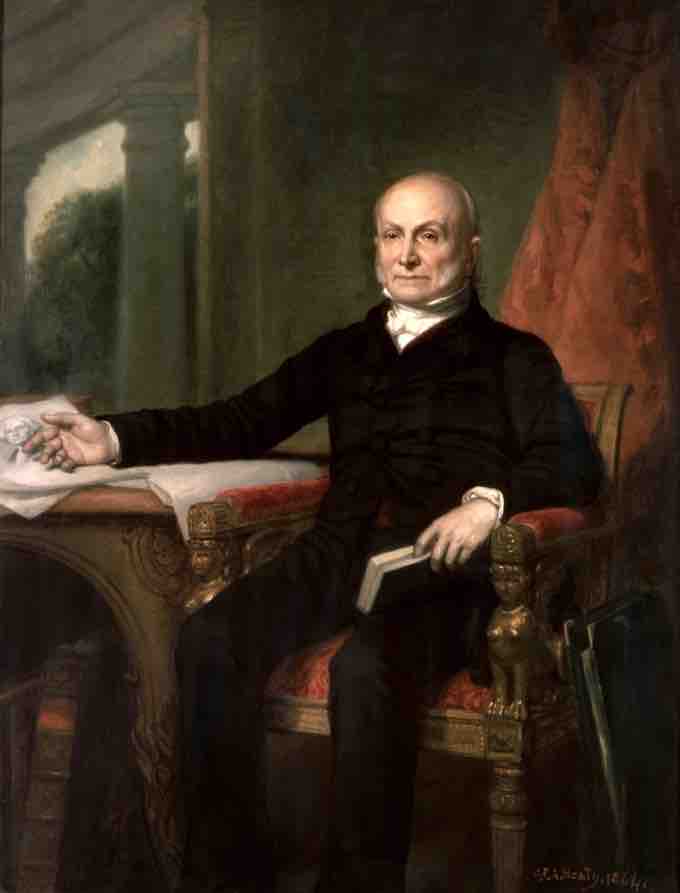John Quincy Adams
John Quincy Adams, the sixth president of the United States, was the son of former President John Adams. The younger Adams began his term in office on March 4, 1825, after the House of Representatives decided the 1824 election. The Adams administration's record was mixed: It saw some domestic policy achievements and some minor foreign-policy achievements. Adams encouraged internal improvements (such as roads, ports, and canals), the founding of a national university, and federal support for the arts and sciences. He favored a high tariff, which made imports more expensive and thus encouraged the construction of U.S. factories. He restricted land sales to slow westward expansion. He also reduced the national debt from $16 million to $5 million, the remainder of which was paid off by his successor. However, opposition from the states'-rights faction of a hostile Congress limited many of his proposals.
Domestic Policies
The American System
During his term, Adams worked on transforming America into a world power through "internal improvements" as a part of the "American System" of economics. This system consisted of a high tariff to support internal improvements such as road-building, as well as the charter of a national bank to encourage productive enterprise and to form a national currency. In his first annual message to Congress, Adams presented an ambitious program for modernization that included roads, canals, a national university, an astronomical observatory, and other initiatives. The support for his proposals was mixed, mainly due to opposition from Andrew Jackson's followers, who were angered by the controversial results of the 1824 election.
Internal Improvements
Some of Adams's proposals were adopted, such as the extension of the Cumberland Road into Ohio with surveys for its continuation west to St. Louis. The Chesapeake and Delaware Canals and the Louisville and Portland Canals around the falls of the Ohio were constructed, as was the connection of the Great Lakes to the Ohio River system in Ohio and Indiana. In addition, the Dismal Swamp Canal in North Carolina was enlarged and rebuilt.
Tariffs
One of the issues that divided the administration was protective tariffs, of which Henry Clay was a leading advocate. After Adams lost control of Congress in 1827, the situation became more complicated. By signing into law the Tariff of 1828 (labeled by critics as the "Tariff of Abominations" and quite unpopular in parts of the South), he further antagonized the Jacksonians.
American Indian Policies
Adams's policies toward the American Indians also caused him trouble. Settlers on the frontier who were constantly seeking to encroach westward cried for a more expansionist policy. When the federal government tried to assert authority on behalf of the Cherokees, the governor of Georgia took up arms. Adams defended his domestic agenda as continuing James Monroe's policies. In contrast, Jackson and Martin Van Buren instigated the policy of American Indian removal to the West, later leading to the Trail of Tears.
Foreign Policies
During his tenure as secretary of state, Adams was the chief designer of the Monroe Doctrine. He had witnessed the Barbary Wars against the Islamic pirates of North Africa and the Greek War of Independence waged against the Ottoman Turks. Adams accepted that the Greek fight for independence from the Turks was only the beginning of a long conflict between Islam and the West. Although he sympathized with the Greeks and held a deep mistrust of the defeated Muslims, he was reluctant to support America's involvement in continuing wars far from home.
During his term as president, however, Adams achieved little of long-term consequence in foreign affairs. A reason for this was the opposition he faced in Congress, where his rivals prevented him from accomplishing much. Among his diplomatic achievements were treaties of reciprocity with a number of nations, including Denmark, Mexico, the Hanseatic League, the Scandinavian countries, Prussia, and Austria. However, thanks to the successes of Adams's diplomacy during his previous eight years as secretary of state, most of the foreign policy issues he might have faced had been resolved by the time he became president.

John Quincy Adams
Portrait of John Quincy Adams by George Peter Alexander Healy (1858).